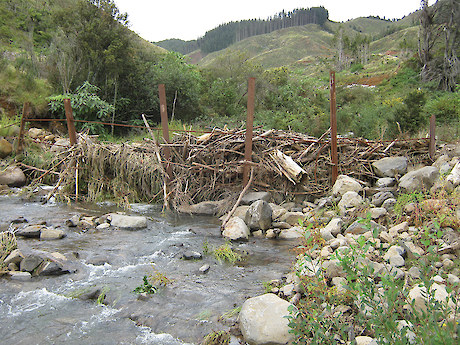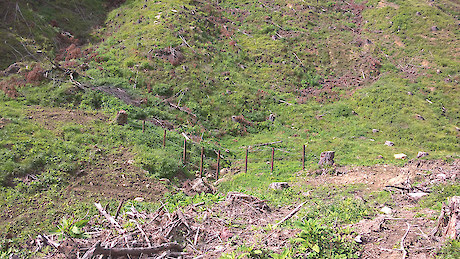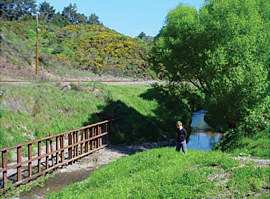 These small traps were constructed to limit debris crossing from the forest into the adjoining propertyThe aim of debris traps is to catch larger slash that would otherwise be transported out of a catchment in flood flow conditions. They are often used in high risk harvest and post-harvest river catchments to limit slash movement downstream from the forest, especially where it could cause problems for downstream property owners or infrastructure like roads, bridges, culverts, farm fencing, and recreational areas. Debris traps are generally constructed in the channel of a river. Debris traps need to be carefully located, designed and constructed. Refer to Debris Flow Control Structures for Forest Engineering, D.F. VanDine, British Colombia Ministry of Forests 1996 and www.geobrugg.com/en/Debris-flow-barrier-UX-7949,7859.html.
These small traps were constructed to limit debris crossing from the forest into the adjoining propertyThe aim of debris traps is to catch larger slash that would otherwise be transported out of a catchment in flood flow conditions. They are often used in high risk harvest and post-harvest river catchments to limit slash movement downstream from the forest, especially where it could cause problems for downstream property owners or infrastructure like roads, bridges, culverts, farm fencing, and recreational areas. Debris traps are generally constructed in the channel of a river. Debris traps need to be carefully located, designed and constructed. Refer to Debris Flow Control Structures for Forest Engineering, D.F. VanDine, British Colombia Ministry of Forests 1996 and www.geobrugg.com/en/Debris-flow-barrier-UX-7949,7859.html.
The NES-PF has many permitted activity conditions for installing, using, maintaining and removing debris traps. A resource consent is required if any of the NES-PF permitted activity conditions cannot be met, so check the regulations prior to construction. Resource consent is needed to install debris traps in catchments larger than 20 ha, unless the debris trap is located on a terrace on one side of the river as opposed to in the active ‘bankfull’ bed of the river. The terrace(s) should allow the overflow of any excess material that may build up against the trap, to reduce pressure and risk of the structure failing.
 Logs can be an easy and effective option in this situationCareful location of debris traps is critical to reduce impact on the river, effectively trap larger debris, and for ease of access for construction and removal of trapped material. It is preferable to locate the debris trap in a location with a readily available area to dispose of any trapped material. For example, a flat area above flood flow level. This will reduce the cost of maintaining the debris trap. If cleaning requires debris to be removed off-site, then the structure will need to have truck access. Do not construct where the natural alignment of the river could lead to the channel alignment or gradient being altered by debris building up behind the structure and creating a weir. Also, do not locate a debris trap where it will cause erosion of the banks and bed of a river, or if the debris trap could adversely affect downstream properties and infrastructure.
Logs can be an easy and effective option in this situationCareful location of debris traps is critical to reduce impact on the river, effectively trap larger debris, and for ease of access for construction and removal of trapped material. It is preferable to locate the debris trap in a location with a readily available area to dispose of any trapped material. For example, a flat area above flood flow level. This will reduce the cost of maintaining the debris trap. If cleaning requires debris to be removed off-site, then the structure will need to have truck access. Do not construct where the natural alignment of the river could lead to the channel alignment or gradient being altered by debris building up behind the structure and creating a weir. Also, do not locate a debris trap where it will cause erosion of the banks and bed of a river, or if the debris trap could adversely affect downstream properties and infrastructure.
Good design is essential. This will help ensure that the debris trap is effective, and has met regulatory requirements. Design the trap for a minimum six year engineered life, to ensure that the structure will be effective for the length of the post-harvest ‘window of vulnerability’, when slash movement is more likely. There must be free movement of water through the structure and fish passage must be provided. Consider using specialist engineering advice when planning and designing larger structures, or where the consequences of failure could be significant.
There are several design features that should be incorporated to reduce the risk of the structure from failing, and to minimise the combined energy of water and weight of debris on the trap during peak flows:
- Trap the larger debris only, rather than trapping or damming all debris
- Construct in a low gradient reach of the river, if possible
- Position at right angles to the river. If there is a natural bench, then slightly angle it downstream to aid slash being deposited onto it. There is evidence that a tapered, constructed debris arrestor is effective for directing debris to banks, but they require longer length and likely more irons/beams in the river
- Consider whether a series of debris traps (two or more) would be a better solution than one slash trap.
- Debris traps are often made from rammed railway irons or steel beams threaded with wire rope, and anchored solidly at each end. The following provides guidance for their installation:
- Use the largest railway iron gauge available or appropriately specified steel universal beams, such as I-beams or RSJs
- Build the trap at least 0.5-1.0 m higher than the river bed
- Drive irons/beams into the river bed to a depth of at least 1.5 m
- Space railway irons/beams 1.5-2 m apart and no closer than 1.5 m. If they are closer too much material could be trapped
- The irons should be no more than 2 m above the river bed (if higher, a resource consent is required)
- Ensure there are smooth-sided holes cut in the upper sections of the irons/beams (for threading the wire)
- Support railway iron/beam uprights with a wire rope of minimum 22 mm diameter
- Anchor the wire rope to deadmen or large trees on either river bank to secure the slash trap. Insert a knot in the rope and supporting clamps on either streambank to secure the slash trap. The anchors are an integral component of the structure. Do not anchor onto stumps as these lose root strength rapidly. If you anchor to standing trees gauge their windthrow vulnerability
- Maximise tension in the rope
- Secure clamps to the wire rope immediately on either side of the railway irons/beams to create rigidity. Clamps stop the irons/beams from being forced out of alignment when under pressure
- Short logs or railway irons/beams can be driven into the terraces adjacent to the slash trap, to catch more material in high flows
- If it is likely that trapped debris could divert river flow during a flood event, the bank should be armoured to prevent scouring
- Consider excavating, if necessary, a larger catch basin if space allows.





